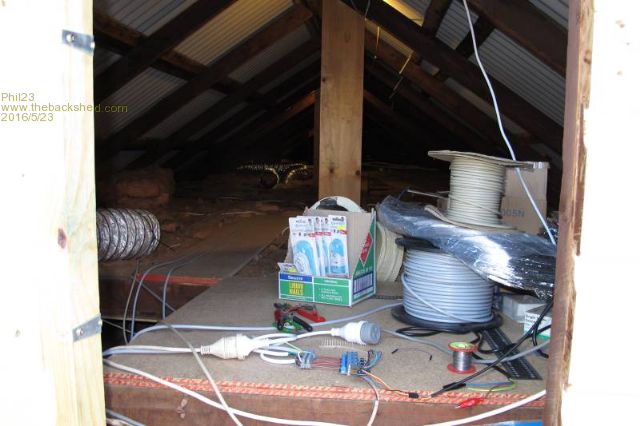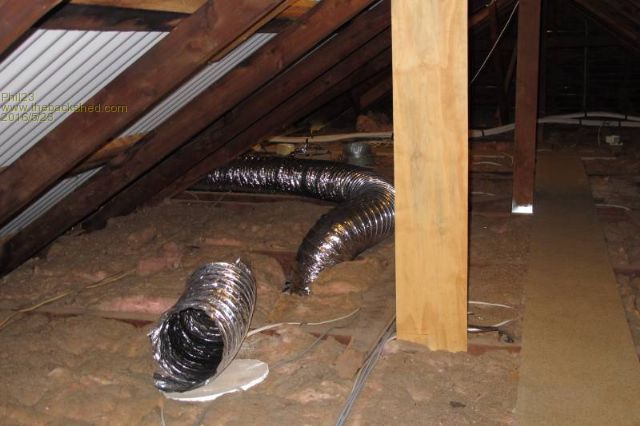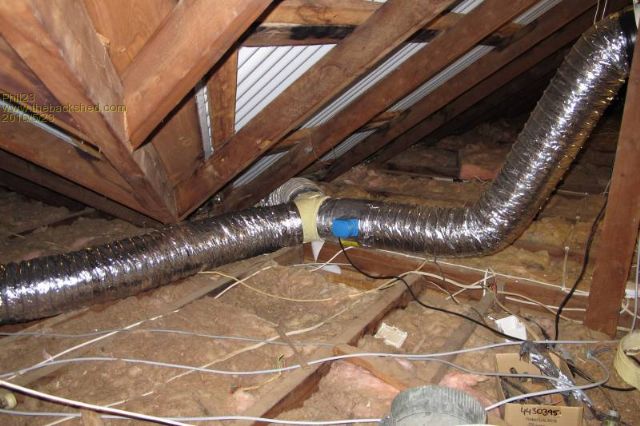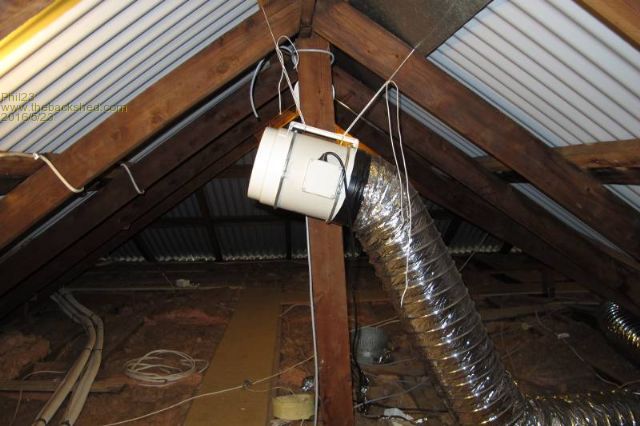
|

|
Forum Index : Solar : Cooling Opinions.
| Page 1 of 2 |
|||||
| Author | Message | ||||
| Phil23 Guru Joined: 27/03/2016 Location: AustraliaPosts: 1664 |
Damn, Just wrote a long winded post about the power usage of my fans to supposedly keep the roof temperatures down. IE LOST it. So brief version. Using 2 to 3 kWh a day to try & lower my ceiling space temps. about 230m² of roof area in plan view. Am I achieving anything, or effectively pissing on a 1000 hectare bushfire in an attempt to control it. Can add more details when I'm over the MS frustration. Cheers Phil. |
||||
| Boppa Guru Joined: 08/11/2016 Location: AustraliaPosts: 814 |
Ive always been impressed by the old whirlybirds, they actually work well (cheap ones really need bearing replace,ment or repacks I found) the ones on my sisters place now actually turn slowly on hot days even with no wind, I suspect that they spin so easy now that the hot air from inside the roof escaping is what makes them spin! Made a huge difference to keeping the roof cavity cooler (lol I spend a lot of time up there for some reason) |
||||
| Phil23 Guru Joined: 27/03/2016 Location: AustraliaPosts: 1664 |
The 3 whirly birds here have DC exhaust fans in them, think around 35W a piece. Add to that a 250mm duct fan pumping 800m³/hour of ambient air into the roof. It uses a bit over 100W. The whole lot is currently running about 10 hours a day. Phil. |
||||
Madness Guru Joined: 08/10/2011 Location: AustraliaPosts: 2498 |
There are some types of paint that reflect and/or insulate it from the outside which would keep some of the heat out. What I did once in a house I was renting was to cut a piece of plywood the same size as the person-hole cover, cut hole in it to take a standard domestic fan. This meant I could blow air from inside the house up into the roof cavity to keep it cooler and circulate fresh air into the house. It made quite a difference. There are only 10 types of people in the world: those who understand binary, and those who don't. |
||||
| Gizmo Admin Group Joined: 05/06/2004 Location: AustraliaPosts: 5078 |
Sorry about the original post been lost, browsers can be a pain. When I'm typing a long post, I start to get nervous after a couple of paragraphs. Sometimes I'll copy to Notepad and finish it there, then copy back to the forum when done. I run a single exhaust fan to vent out the hot air in my ceiling. The fan is mounted in the access port to the ceiling. On hot days, 35c or more, if I close the house windows and doors as soon as I wake up, the house will remain under 28c till about 1pm. After that it starts to warm up, and if its going to be a hot day, I then close off my office and turn on its air conditioner. Then at about 5pm, I open all the doors and windows, and turn on the ceiling exhaust fan. My thinking is the fan will draw in the outside air though the windows, into the ceiling, and out the gaps under the roofing iron. Seams to work, by about 8pm the house is cool. I turn off the exhaust fan when I go to bed. My ceiling is well insulated, but the problem with insulation is it keeps heat in as well as out. So a fan to force the air out makes sense. Glenn The best time to plant a tree was twenty years ago, the second best time is right now. JAQ |
||||
| yahoo2 Guru Joined: 05/04/2011 Location: AustraliaPosts: 1166 |
I think you are probably wasting your time. Unless you know the exact path of the air it is possible to actually be inverting hot air down onto the ceiling in a rolling path and actually make it hotter. it is also possible to be drawing or pushing cold air out of the building of course, I cant prove that because I have no clue as to how your house is set up. the basics of insulation usually comes down to stopping air flow and having insulation that is perfectly fluffed and fitted (no gaps). I'm confused, no wait... maybe I'm not... |
||||
| George65 Guru Joined: 18/09/2017 Location: AustraliaPosts: 308 |
Again, don't know how your roof is set up so may or may not be practical. I found a cracked 300W panel over Christmas. Still works fine so I brought it home and put it on the shed roof and wired it to a pair of electric car radiator fans and put it in the shed window. The difference those things make in that 80M2 shed with no insulation is huge. Net cost to run, zero. 2 Cheap panels, 2 cheap car radiator fans, You could move a lot of air very cheaply. You may have to cut and frame up vents in your roof or run some ductwork but you might also be able to replace what is there. The car fans blow a hell of a breeze and I have used them like this in different applications for years. In my last house I had one that sat in the bathroom window opposite my office on the shaded side of the house. Pretty much ran all summer long 24/7 off a transformer through a PWM speed controller. I had in in that window for 6 summers and the thing never looked like failing. that's a LOT of hours and even if you had to get a new one every year, still cheap and worthwhile time and effort. I also had a fan through the manhole cover..... Only I went the other way. I had ductwork going to the top of the roof pitch and a tube fan sucking the hot air down in winter. Amazing the heat that provided. If the sun was out you'd be getting worthwhile warmth. This was proven by my highly sensitive and expensive thermal detectors. Couldn't get in the bathroom where the manhole was for cats! they were always in there because it was the warmest room in the house! I had the lip of the fan protruding through the steel manhole cutout so to prevent drafting on old nights when we had the AC on I'd put a shower cap over the fan end to seal it. Think I'll do a similar setup here this year. The roof is insulated but I think there will still be worth while warmth up there and it's cheap heat when it works. |
||||
| Phil23 Guru Joined: 27/03/2016 Location: AustraliaPosts: 1664 |
That's a little how my gut feeling is. Say there's roughly 230m² of roof in plan view, the older original are is pitched at 35° over 4m wide rooms. The newer additions are covered by a skillion roof, cavity tapering from about 900mm to basically rafter & batten height. Pink bats circa 1996 in all areas. There's a few more photos in this older post. Few pics from that post.... At the moment I just have the second duct fan sitting here on a platform, with 6m of 300mm ducting extending towards the front of the house.    The fan draws 105 Watts on high & displaces 840 cubic metres of air per hour. The main living area, plus adjoining Office/Spare bedroom have a total volume for 215m³, so air turnover is about 4 times per hour. Data is logged for all rooms, including a temp sensor that sits up near this fan.  With all that area & energy at 1000W/m², there's a huge heating source in comparison to the air flow I'm creating. Phil. |
||||
| Phil23 Guru Joined: 27/03/2016 Location: AustraliaPosts: 1664 |
Lol, I usually do just that. There's a file on the Desktop called "Bucket.txt", I usually keep pasting there. Was probably a bit over confident on the new laptop I broke out 2 days ago.... (The one I purchased just before June 30th).... Phil. |
||||
Madness Guru Joined: 08/10/2011 Location: AustraliaPosts: 2498 |
I like your anti vibration mounting of the fan  There are only 10 types of people in the world: those who understand binary, and those who don't. |
||||
| Phil23 Guru Joined: 27/03/2016 Location: AustraliaPosts: 1664 |
Blind cord.... And fully adjustable for both height & angle, just loosen the Reef knots.... (That's the Winter heating fan, obviously). |
||||
| George65 Guru Joined: 18/09/2017 Location: AustraliaPosts: 308 |
One might state the obvious and suggest rather than trying to remove the heated air, you might be better off reducing the heat in there in the first place by insulating your tin roof even on the back of the bearers with sarking. Be a lot better to lift the sheets and do it properly though. They usualy put that there anyway just to stop condensation and as a secondary insurance against leaks. I see you have also picked up on the idea of using the roof heat. Much more elaborate way of doing it than I did but obviously works for you and like that would be real effective seeing the roof is a direct radiator. I guess you could look at the big picture and say what you are spending on roof cooling in summer you are making back in cheap heat in winter! :0) |
||||
| Warpspeed Guru Joined: 09/08/2007 Location: AustraliaPosts: 4406 |
[quote]One might state the obvious and suggest rather than trying to remove the heated air, you might be better off reducing the heat in there in the first place by insulating your tin roof [/quote] I agree, that would be my approach as well. How about fiberglass bats held up under the steel roof by chicken wire ? Its all super light weight, so it will not need much support. Cheers, Tony. |
||||
| Phil23 Guru Joined: 27/03/2016 Location: AustraliaPosts: 1664 |
Might measure the actual wattage I'm using for extraction; it's all out of one point to a simple temp based controller; on above 22°C. Found this Drone pic a friend took. Interestingly it shows the shadowing I'll have getting into Winter. Shot was taken at 1:45pm on May 10th. Basically the house is facing NW, 323° bearing to be exact. The 3 panels at the back are the water heating ones for the Spa that I've mentioned in other posts. Agree with others about additional insulation under the iron. Was thinking foil backed blanket etc, but not sure about lifting the iron, be a mammoth task.... Don't you love how the ColorBond has weathered. Complete roof replaced in December 1996 after a hail storm. (Mostly Cricket Ball sized, but a few that were bigger). Phil. |
||||
Madness Guru Joined: 08/10/2011 Location: AustraliaPosts: 2498 |
A really good way to determine shadows is with Google Sky maps on your phone. You can enter a date and time hold the phone up and see where the sun will at the time and date set. You also can play a day in fast forward and track the suns path across the sky. There are only 10 types of people in the world: those who understand binary, and those who don't. |
||||
| yahoo2 Guru Joined: 05/04/2011 Location: AustraliaPosts: 1166 |
I gritted my teeth and sat through Corbett Lunsford and his Home Performance youtube videos. Not for the easily bored but I learned a lot about house construction and insulation strategy. In some videos they do some testing and calculation and come up with a number for % outside for all the rooms in a house, it is pretty amazing to see a room that looks like it is well sealed and insulated get a 95% outside rating. I'm confused, no wait... maybe I'm not... |
||||
| Jarbar Senior Member Joined: 03/02/2008 Location: AustraliaPosts: 224 |
I originally placed an old ceiling fan inside the roof space to disturb the stratification of heat build up through terracotta tiles, this had a remarkably positive effect.Leaving the 1mtr x 0.5mtr external man hole in the verandah open allowed lots of cooler air to mix in. But no temps were recorded, other than friends who asked why our house was so cool and was the AC on. This then led to experiments with an exhaust fan, but instead of trying to draw hot air out, I used it to pump ambient air into roof-space. Mounted in the eaves on the south side of the building, the ambient air temp might be 35 degrees but is displacing roof space temps approaching 60degs and more. As cooler air falls it tends to place a blanket of cooler air over the ceiling insulation, displacing warmer air.The exhaust fan delivers 650 cubic meters an hour from a 50 watt motor. Even if its only for a 50 to 100mm above the ceiling what happens above that is mostly inconsequential. I have recorded roof-space ceiling temps and found up to 10 degrees cooler can be achieved.It may also be reducing wall temps as some air displacement may also be occurring there as well. I have sourced some thermostatic switches so it can automatically respond to temp, but are yet to be fitted.Was using a Heater-mate variable thermostat but kept going into fault mode requiring constant resetting.After replacing three under warranty gave up trying. Fan motor maybe didn't draw enough current??? If you have a toilet or bathroom fan in a room with an outside window,a similar effect can be achieved, first by opening the window, turning on the fan and then closing the door.A draft stopper helps. This then pumps cooler air into roof-space.This would work particularly well on a second story of a house. I had plans of commercializing this concept but ill health has stymied that and many other aspirations.Just imagine how much energy reduction could be achieved if every house was doing the above.Dependent on insulation quality internal temps reduce, for each degree reduction in room temperature approximately 10% less energy is used by Air conditioner. Anyone interested in pursuing this idea, please let me know. This is the third summer utilizing this concept. Anthony "Creativity is detirmined by the way you hold your tounge".My Father "Your generation will have to correct the problems made by mine".My Grandfather. |
||||
| Jarbar Senior Member Joined: 03/02/2008 Location: AustraliaPosts: 224 |
To add to the above, if a home has an evaporative AC and the house has an internal man-hole, instead of exhausting all the air through open windows some can be directed into the roof-space via the man-hole. This too will displace the warm air accumulating in roof-space. If no internal man-hole exists a louvered closable vent could be installed and open or closed as needed.Some older homes already have molded plaster vents in the ceilings that would inadvertently be achieving a similar outcome as would standard internal exhaust fans. They unfortunately loose heat in winter and require draft-stoppers. Anthony "Creativity is detirmined by the way you hold your tounge".My Father "Your generation will have to correct the problems made by mine".My Grandfather. |
||||
| M Del Senior Member Joined: 09/04/2012 Location: AustraliaPosts: 155 |
To add to Jarbar's and a couple of others comments. I use both the bathroom fan method and a car radiator fan under the wirly bird idea. When we first moved in there was no ceiling insulation, ceiling temp was above 70 degrees, inside temps approached 55 early summer. Roof/ceiling insulation went in the first summer we were here, 10-15 degrees difference inside, roof space now at 65 degrees. Fitting a wirly bird a year later added another 5 degree drop to both. With the bathroom fan running all day another 5 degree reduction in roof space/ceiling space and 5 degrees inside. Then I added a 10 inch 12v radiator fan under the wirly bird powered by a 40w solar panel, this dropped the roof space temp again to where it rarely gets over 45 degrees, the ceiling under the insulation gets to about 35 degrees. Inside the house still it hits high 30s during a stretch like over the last couple of weeks of 45ish days, so more to do including screening some windows with shade cloth or tressles against the wishes of the minister of war&finance. Active cooling is via a portable air con dual plumbed at a rear window, works well until a window is opened to supply fresh air after going outside for a cigarette, AAAGGGHhh  Mark |
||||
| Phil23 Guru Joined: 27/03/2016 Location: AustraliaPosts: 1664 |
Have to have a look. I've always used Suncalc either in my browser or with the app on my phone. In the browser I can zoom on the satellite view & set a shadow height & watch it move about as I slide the time thingo. Phil |
||||
| Page 1 of 2 |
|||||